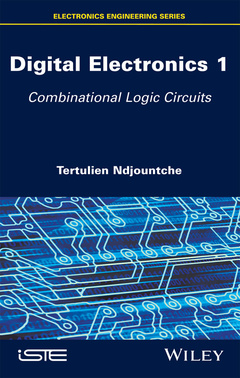Description
Digital Electronics 1
Combinational Logic Circuits
Author: Ndjountche Tertulien
Language: English
Subject for Digital Electronics 1:
Keywords
radix; decimal; representations; integers; representation; part; fractional; number; binary numbers; arithmetic operations; real numbers; errors; error; table; function; logic; truth; theorems; multiple; outputs
276 p. · 16.3x23.6 cm · Hardback
Description
/li>Contents
/li>Biography
/li>
The omnipresence of electronic devices in our everyday lives has been accompanied by the downscaling of chip feature sizes and the ever increasing complexity of digital circuits.
This book is devoted to the analysis and design of digital circuits, where the signal can assume only two possible logic levels. It deals with the basic principles and concepts of digital electronics. It addresses all aspects of combinational logic and provides a detailed understanding of logic gates that are the basic components in the implementation of circuits used to perform functions and operations of Boolean algebra. Combinational logic circuits are characterized by outputs that depend only on the actual input values.
Efficient techniques to derive logic equations are proposed together with methods of analysis and synthesis of combinational logic circuits. Each chapter is well structured and is supplemented by a selection of solved exercises covering logic design practices.
Preface ix
Chapter 1. Number Systems 1
1.1. Introduction 1
1.2. Decimal numbers 1
1.3. Binary numbers 2
1.4. Octal numbers 4
1.5. Hexadecimal numeration 5
1.6. Representation in a radix B 6
1.7. Binary-coded decimal numbers 7
1.8. Representations of signed integers 8
1.8.1. Sign-magnitude representation 9
1.8.2. Two’s complement representation 10
1.8.3. Excess-E representation 12
1.9. Representation of the fractional part of a number 13
1.10. Arithmetic operations on binary numbers 16
1.10.1. Addition 16
1.10.2. Subtraction 17
1.10.3. Multiplication 18
1.10.4. Division 19
1.11. Representation of real numbers 20
1.11.1. Fixed-point representation 20
1.11.2. Floating-point representation 22
1.12. Data representation 28
1.12.1. Gray code 28
1.12.2. p-out-of-n code 29
1.12.3. ASCII code 31
1.12.4. Other codes 31
1.13. Codes to protect against errors 31
1.13.1. Parity bit 31
1.13.2. Error correcting codes 33
1.14. Exercises 36
1.15. Solutions 38
Chapter 2. Logic Gates 49
2.1. Introduction 49
2.2. Logic gates 50
2.2.1. NOT gate 51
2.2.2. AND gate 51
2.2.3. OR gate 52
2.2.4. XOR gate 52
2.2.5. Complementary logic gates 53
2.3. Three-state buffer 54
2.4. Logic function 54
2.5. The correspondence between a truth table and a logic function 55
2.6. Boolean algebra 57
2.6.1. Boolean algebra theorems 59
2.6.2. Karnaugh maps 65
2.6.3. Simplification of logic functions with multiple outputs 73
2.6.4. Factorization of logic functions 74
2.7. Multi-level logic circuit implementation 76
2.7.1. Examples 77
2.7.2. NAND gate logic circuit 78
2.7.3. NOR gate based logic circuit 80
2.7.4. Representation based on XOR and AND operators 82
2.8. Practical considerations 89
2.8.1. Timing diagram for a logic circuit 90
2.8.2. Static hazard 90
2.8.3. Dynamic hazard 92
2.9. Demonstration of some Boolean algebra identities 93
2.10. Exercises 97
2.11. Solutions 101
Chapter 3. Function Blocks of Combinational Logic 115
3.1. Introduction 115
3.2. Multiplexer 115
3.3. Demultiplexer and decoder 121
3.4. Implementation of logic functions using multiplexers or decoders 127
3.4.1. Multiplexer 127
3.4.2. Decoder 129
3.5. Encoders 130
3.5.1. 4:2 encoder 131
3.5.2. 8:3 encoder 134
3.5.3. Priority encoder 136
3.6. Transcoders 143
3.6.1. Binary code and Gray code 143
3.6.2. BCD and excess-3 code 149
3.7. Parity check generator 155
3.8. Barrel shifter 160
3.9. Exercises 165
3.10. Solutions 173
Chapter 4. Systematic Methods for the Simplification of Logic Functions 203
4.1. Introduction 203
4.2. Definitions and reminders 203
4.2.1. Definitions 204
4.2.2. Minimization principle of a logic function 204
4.3. Karnaugh maps 205
4.3.1. Function of five variables 205
4.3.2. Function of six variables 207
4.3.3. Karnaugh map with entered variable 208
4.3.4. Applications 215
4.3.5. Representation based on the XOR and AND operators 220
4.4. Systematic methods for simplification 220
4.4.1. Determination of prime implicants 221
4.4.2. Finding the constitutive terms of a minimal expression 224
4.4.3. Quine–McCluskey technique: simplification of incompletely defined functions 235
4.4.4. Simplification of functions with multiple outputs 235
4.5. Exercises 241
4.6. Solutions 243
Bibliography 257
Index 259
Tertulien Ndjountche received a PhD degree in electrical engineering from Erlangen-Nuremberg University in Germany.
He has worked as a professor and researcher at universities in Germany and Canada. He has published numerous technical papers and books in his fields of interest.



